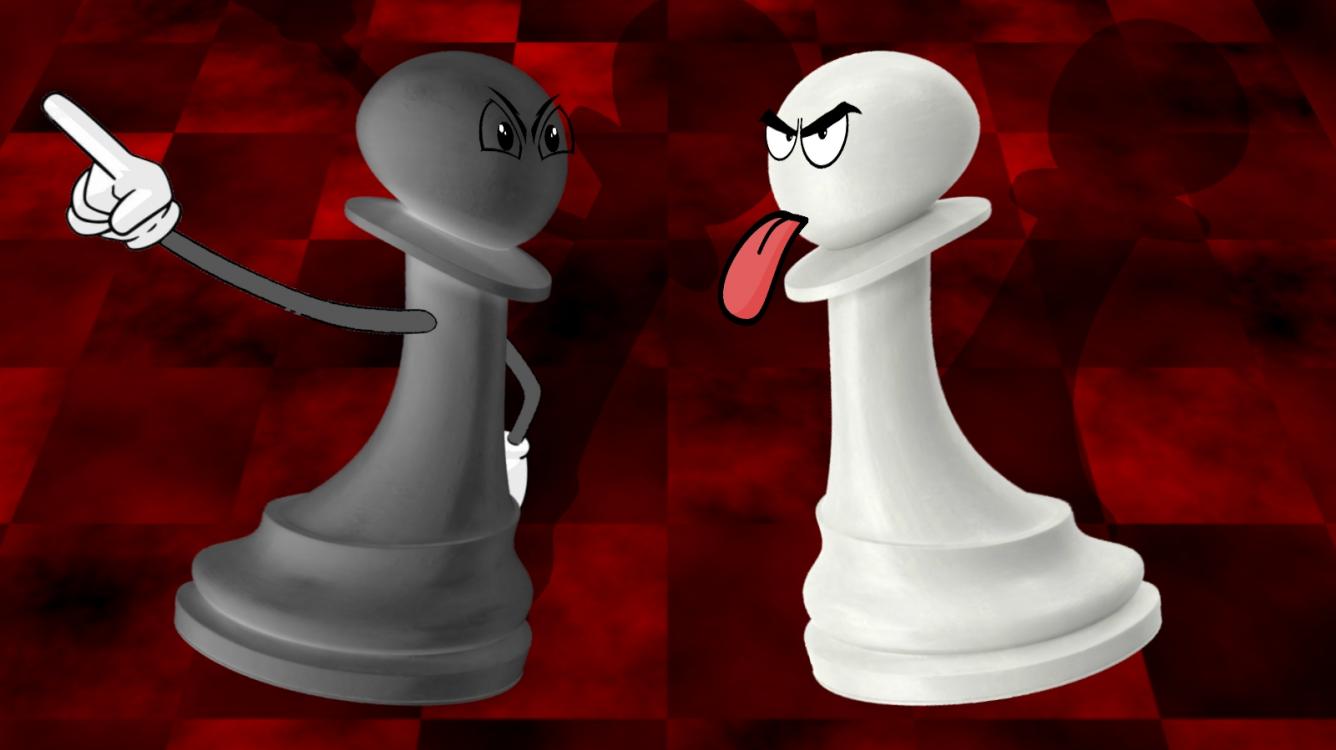
Pawn endings... pawn endgame positions taken from games of the last two years
Taking as basis my daily games, I was most of times feeling sure when the game was coming in an endgame. One way or another, I would find a solution, even if it wasn't the best. But an exception was pawn endgames. Not sure why! I wasn't aware of the theory? Were more complex? Maybe in the other endgames, an outcome of possible exchanges was more obvious! Not sure. However, I decided to study some, making a touch with some terms and themes, that I wasn't so much aware. But also reexamining some already known. Don't know if I've become wiser, but I have surely more confidence.
On a second [maybe third-fourth?!] stage I've tried to examine and study recent games, hoping to recognize critical positions, evaluate them better and faster and find possible lines. So here are following some of my finds. And it's noticeable that many of the games are of faster time limits. In any case, my intention was to create a blog where I could find some main terms, themes and meanings, so to remember them more easily...
[Note-disclaimer: all games were found in the TWIC files (1199-1304). They are all set in puzzle form. Some are the played lines, some not & just inspired of the played positions. And some maybe have an alternate equally good line. For the latter I always set the start of the puzzle in positions where there're unique solutions at the beginning, and if there're alternate solutions after 2-3 moves, I declare it before the puzzle. Tried to categorize them in a way too. All annotated puzzles + the whole games in the end of this post, as a multi pgn to download]
_
Opposition up
A really well-known term obviously. Mostly in K+p vs K endgames and most of times has a form of mutual zugzwang, where the side to play second would be able to achieve his/her goal [win or draw]. But opposition as a winning factor may occur and in a little more complex positions, especially when pawn structures are symmetrical.
Liren has just played 49...g5, with a hope to confuse opponent. But Carlsen responded well keeping draw. [3move puzzle]
_
Zugzwang. Just some cases... up
When any move would worsen position.
Play like Anand and win [2move puzzle-2nd move could be a similar]
_
Play like Ponomariov and win [3move puzzle] up
_
A missed win by Perez [5move puzzle-2nd could be an alternate. In any case an interesting missed win line, using opposition and triangulation. Also interesting how Lagrave managed to win ~ look in the pgn] up
_
Play like Harikrishna and win [3move puzzle] up
_
And a pawn + Bishop endgame. Found it beautiful and having same principles as endgames only with pawns. Play like Demidov and win [5move puzzle] up
_
Square rule up
A basic principle permitting the King to catch an advancing pawn or not. It may have many usages.
Pons used it as a threat and won [2move puzzle]
_
A missed win by Caruana. In this case square rule could be used to avoid the drawish rook pawns [7move puzzle] up
_
Do u remember the famous Reti endgame study where King uses the square rule so to be able to catch a pawn and support his own on the same time? Moving diagonally? Something like battle in two fronts.

Fedoseev surely remembered it [7move puzzle - after first two moves white resigned]. In any case I think it's based on the same rule. up
_
The following game was really interesting. It's a missed win, a draw. The interesting thing is that both players, failed to see the winning line for black. They both seem to be absorbed in opposition rules. Of course in faster time limits. Chess psychology?! [4move puzzle] up
_
Breakthroughs and causing defects on pawn structure up
Two terms that can have similarities as both are usually achieved by a pawn exchange or sacrifice.
Play like Anand [8move puzzle]
_
Possible defects on pawn structure. Play like Nepomniachtchi and draw [1move puzzle] up
_
White is winning. Find a move that could bring some chances to draw. Van Foreest did [7move puzzle - first move not winning, however the best] up
_
A really beautiful endgame, surely on the theme of causing defects on pawn structure, but with elements of a cutting the path theme too [14move puzzle - after 8th move the rest could have some reversed order] up
_
Cutting the path up
A term I'm using to express the obvious, when pawns create a wall. As I touched this on the previous game, here's a more simple one [6move puzzle - 4th move could have an alternate]
_
...and a more complex one. A missed win for black and interesting how Nakamura managed to win in the end [look in the pgn] [7move puzzle] up
_
A typical 2 vs 1 pawn endgame. Cases of non mutual zugzwang while Kings in opposition up
Reading the theory, I've noticed that some basic setups have been solved. The following two diagrams are illustrating a typical one, that I think it should be in mind. A case of non mutual zugzwang while Kings are in opposition. Generally opposition gives to the one that has it the advantage [to win or draw]. However seems that its biggest enemy is a reserve tempo, for obvious reasons. And further a reserve tempo can sometimes be weakened by triangulation. But these really in general...
 |
 |
|
As a rule: In this setup, white wins whoever has the opposition. If white has it he will manage to transpose it into a vertical one and push black K down. If black has it, white will bring black K one file right, use his reserve tempo by playing the right pawn [blocking the pawns and cutting the path to black K]. Then if black K stays on the same rank, white will play the other pawn, exchanges will follow and white K moving diagonally will be on the other side, in front of his pawn, winning. Exception: as it's obvious from the previous white's strategy, if this setup is far right [the pawns are rook pawns], white can't go from the other side [there's no other side], so in order to win should have the opposition from the beginning. Exception of the exception: if these rooks pawns are unmoved, either black or white, it's again a non mutual zugzwang but for black, who can draw in any case. If the black pawn is unmoved, black will go to the corner and be stalemated. If white pawn is unmoved, it means that the black one is really advanced, and black K has the luxury to let one white pawn to get passed, and be in time. There's also a single setup where black has a bishop pawn and manages to use it in a known way to draw, even if white queens first. |
As a rule: similar setup with the previous but with Kings on the other side. So if there's enough space left from pawns [3 files++, meaning far left white pawn = at least c-pawn], whatever is said for 1st diagram is valid, as white K can go from the other side. As a second rule: if there's no enough space to the left, one should have opposition. Black having it will manage to keep white K on the same rank. White having it will manage to push. Exception: if this setup is on the far left up corner, black can use it to be stalemated. So it's a draw either way. This exception will be seen in a game below. 2nd exception: one file right of the previous exception's setup, its a again a non mutual zugzwang in favor of white, as his pawns are really advanced and black K cant catch. Trick: White, having opposition can't be exactly right next to his pawn, as then black can push his own pawn, giving check and forcing an exchange. And so doubling white's pawns = easy draw. |
_
 |
Generally a King having opposition in front of his own pawn is a win. Not having it is a draw. However, if this occurs while pawn has reached 5th rank, it's a win either way. As the strong side can use the reserve tempo to gain opposition but the weaker side has not enough space to triangulate and negate this reserve tempo. The use of this typical setup can be seen in some endgame studies, when the first winning move is securing a pawn on 5th rank. |
_
With all the above in mind, let's see the next positions...
Firstly a simple one [4move puzzle - 3rd move could be an alternate] up
_
And a more complex one. A missed win by Nakamura, in a position where an exception of the previous can be found and a use of another non mutual zugzwang case too [7move puzzle - 3rd and 4th move could have reversed order] up
_
Corresponding square system up
The basic case of the mutual zugzwang. Positions where the side to move can't achieve his goal [to win or draw]. Opposition with one pawn is a simple case of corresponding square system. But maybe the simplest one. Generally I've noticed that they are pawn structure systems where there're at least two points that a King can use to break through and win. When these systems apply there's always a unique square from one side for one King that corresponds to another square of the other side for the other King, that constitute a system of mutual zugzwang.
I was really happy that I actually found a game where a system of this kind is applied. I think it's a quadratic system with non-unambiguous rear. Play to draw [6move puzzle] or check the diagrams that follow... up
_
 |
 |
_
Update-addition: 10.11.2019 / 3days after
After an indication at the comments [look at the latest at the time and thank you for this], I decided to add a corrected - more complete diagram of the corresponding square system of the above game [the above and the pgn haven't been changed].

Brief notes:
- The corresponding squares numbered 1, 2 & 3 constitute probably a quadratic system with non-unambiguous rear, having two connective links for white to a solid numbered 5 position.
- These two connective links [f1, f2] are suitable squares for white when black is on g5 [=b.a], but as are one next to the other, the squares can't be considered strictly corresponding [they should be considered more a non-unambiguous rear].
- Squares numbered 5 are corresponding but possibly also belonging to an other system. I think it could be triangular [or some kind of opposition] but with a lot of doubt.
- And this, as they are created two more squares, [h2, h3=w.a] for white that can hold draw when black is on g5, but with an alternate, more complex, line [look in the pgn]. Being connected too, they can't also be considered strictly corresponding.
- But they could work with opposition rules, blocking a breakthrough.
...the 19 positions with the complete games to download
_
_
....thanx for reading

